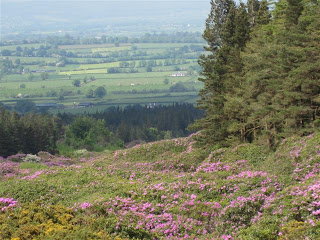On Saturday, we had a nice breakfast at Legends. The owners, Graziella & Liam, are selling the place and moving to her home city in Brazil, where she will return to her teaching job and they will look for another inn to purchase. They should be successful as they’ve done a good job in Cashel. Since our hotel was located adjacent to the parking lot for the attractions, we walked toward the Rock. We tried to go to the Bru Baru Center, but it was closed. This center provides all the information and exhibits you’d ever need on this area. Brian Baru once conquered everything in sight, became high king of Ireland, and was the progenitor of the O’Brien clan.
 The Rock of Cashel is a big hill with rocky outcroppings on the top. It is quite windy up there and commands an excellent view of the entire region. It is said that Patrick converted the local king to Christianity on this site and it has been a monastery since the sixth century. In the eleventh century. a chapel was built for Cormac McCarthy, in the twelfth the cathedral was erected, the thirteenth found defensive towers added, and the choral was built in the fourteenth. In the seventeenth century, Cromwell’s troops burned the place and it fell into disuse. The choral has been completely restored; the remainder of the site is being maintained as is (in ruins) and will not be restored.
The Rock of Cashel is a big hill with rocky outcroppings on the top. It is quite windy up there and commands an excellent view of the entire region. It is said that Patrick converted the local king to Christianity on this site and it has been a monastery since the sixth century. In the eleventh century. a chapel was built for Cormac McCarthy, in the twelfth the cathedral was erected, the thirteenth found defensive towers added, and the choral was built in the fourteenth. In the seventeenth century, Cromwell’s troops burned the place and it fell into disuse. The choral has been completely restored; the remainder of the site is being maintained as is (in ruins) and will not be restored.
 There are a number of other churches and abbeys in the area, so we walked to Hoar Abbey which is a short distance away.
There are a number of other churches and abbeys in the area, so we walked to Hoar Abbey which is a short distance away.
We had a very nice lunch and then took a walk around the town. The town of Cashel, in County Tipperary, is quite small and compact, but very nice. However, it is very tourist oriented.
We then took an hour’s drive to Mitchelstown in County Cork. On the way we stopped off at the Mitchelstown Cave. There are a lot of these limestone caves in Ireland, but only a few are open to the public. The tour took us several hundred meters underground (the temperature is a constant 59 degrees). The cave was discovered 150 years ago but has only been a viable tourist destination since the seventies when electricity was introduced inside the cave. Now they even hold concerts in there. There are numerous examples of stalactites and stalagmites and other strange looking formations.
 We have rented a cottage for a week about six miles outside Mitchelstown. Definitely a rural setting; we even have cows in the lot next door. The cottage is named Croughmore and has been in the family of Liam and Ann Moher since 1864, although it has been remodeled and the roof re-thatched.
We have rented a cottage for a week about six miles outside Mitchelstown. Definitely a rural setting; we even have cows in the lot next door. The cottage is named Croughmore and has been in the family of Liam and Ann Moher since 1864, although it has been remodeled and the roof re-thatched.

We went shopping at the Tesco in Mitchelstown, came back home to eat and spent the evening studying up on Cork and Kerry.
 Waterford is famous for crystal so we next went to the crystal factory. It was founded in 1783 and has been world famous since. We had a tour of the factory and got to see the process of creating these beautiful pieces. The tour ended up in the store and we successfully resisted temptation--while we appreciate the beauty of the pieces and the skill required to produce them, we have to admit that crystal really is not our style.
Waterford is famous for crystal so we next went to the crystal factory. It was founded in 1783 and has been world famous since. We had a tour of the factory and got to see the process of creating these beautiful pieces. The tour ended up in the store and we successfully resisted temptation--while we appreciate the beauty of the pieces and the skill required to produce them, we have to admit that crystal really is not our style. Then we drove to our B&B in Butlerstown, the Coach House. This is part of an old estate which has fallen into complete disrepair and ruin; the owner has restored the coach house as a B&B. The setting is green and pastoral, complete with cows next door.
Then we drove to our B&B in Butlerstown, the Coach House. This is part of an old estate which has fallen into complete disrepair and ruin; the owner has restored the coach house as a B&B. The setting is green and pastoral, complete with cows next door.
















































